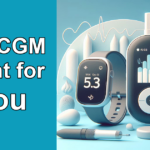Having diabetes poses a significant threat not just to our overall health but also to our precious sense of sight. This looming dilemma arises from the damage diabetes can inflict on the delicate blood vessels and nerves within the eyes, paving the way for several vision-robbing conditions. This post will shed light on this easy to overlook aspect of the disease and explore proactive steps to safeguard our eyes from its damaging effects.
Diabetic Retinopathy
At the forefront of diabetes-related eye complications is diabetic retinopathy, which affects the light-sensitive retina at the back of the eye. In its earliest, non-proliferative stage, this condition weakens and causes the retinal blood vessels to leak fluid, creating swelling and distorted vision.
There are two types of diabetic retinopathy: early diabetic retinopathy and advanced diabetic retinopathy.
- Early diabetic retinopathy, also known as nonproliferative diabetic retinopathy (NPDR), is the more common form. In NPDR, the walls of the blood vessels in the retina weaken and bulges may protrude from the walls of the smaller vessels, sometimes leaking fluid and blood into the retina. Larger retinal vessels may also dilate and become irregular in diameter. NPDR can progress from mild to severe as more blood vessels become blocked. If the damage to the blood vessels in the retina leads to a buildup of fluid in the center of the retina (called macular edema), treatment may be needed to prevent permanent vision loss.
- Advanced diabetic retinopathy, also known as proliferative diabetic retinopathy, is a more severe form of the condition. In this type, damaged blood vessels close off, leading to the growth of new, abnormal blood vessels in the retina. These new blood vessels are fragile and may leak into the vitreous, the clear, jelly-like substance that fills the center of the eye. Scar tissue from the growth of these new blood vessels may cause the retina to detach from the back of the eye. If the new blood vessels interfere with the normal flow of fluid out of the eye, pressure may build up in the eye, which can damage the optic nerve and lead to glaucoma.
If left unchecked, it can progress to the proliferative stage, marked by the growth of abnormal new blood vessels that are fragile and prone to bleeding. This can lead to potentially blinding complications like vitreous hemorrhage, where blood leaks into the jelly-like vitreous of the eye, or traction retinal detachment, where scar tissue from the abnormal vessels pulls the retina away from its normal position.
Diabetic Macular Edema
But retinopathy is not the only vision threat posed by diabetes. The disease also increases the risk of developing diabetic macular edema, where fluid accumulates in the macula – the part of the retina responsible for sharp central vision crucial for activities like reading, driving, and recognizing faces. This swelling can profoundly impact visual acuity and ability to perform tasks requiring detailed sight.
Glaucoma
Glaucoma is often referred to as the “silent thief of sight” because it rarely presents any symptoms in its early stages. This makes regular eye examinations extremely important for individuals with diabetes, as they are already at a higher risk.The elevated eye pressure in glaucoma is caused by a buildup of fluid in the eye, which can damage the optic nerve over time.
Diabetes is known to affect blood vessels throughout the body, including those in the eyes. This can lead to poor blood circulation and increased pressure within the eye, further increasing the risk of developing glaucoma. Poorly controlled blood sugar levels in diabetics can also contribute to the progression of glaucoma. .
Cataracts
Those of us with diabetes are also at a higher risk of developing cataracts, which is a condition where the eye’s lens becomes cloudy. Cataracts tend to develop earlier and progress more rapidly in individuals with diabetes compared to those without the condition. Left untreated, cataracts can significantly impair vision and quality of life.
The Impact on Quality of Life
These diabetic eye diseases have a significant impact on quality of life that cannot be overstated. Unchecked, they can rob people of their independence, mobility, and ability to perform daily tasks, leading to social isolation, depression, and a profound reduction in overall well-being.
Something as simple as being unable to read, drive, or recognize loved ones can be incredibly demoralizing. Vision loss also increases the risk of falls and injuries, making routine activities more challenging and potentially unsafe. Catching it early and getting treatment can help save your sight and let you keep doing what you love.
Prevention Through Early Detection and Management
Importance of Regular Eye Exams
To prevent vision loss due to diabetes, it’s crucial to detect and treat eye diseases early on. Regular, comprehensive dilated eye examinations performed by an ophthalmologist or optometrist are crucial, as they can detect signs of retinopathy, macular edema, glaucoma, or cataracts before any noticeable vision loss occurs.
This allows for timely treatment and monitoring to slow or halt disease progression. Individuals with type 2 diabetes should have annual dilated exams, while those with well-controlled type 1 diabetes should undergo these exams every 1-2 years after being diagnosed for 5 years.
Glycemic Control and Lifestyle Factors
But the frontline defense remains strict control of blood sugar levels through adherence to prescribed medications, dietary modifications that limit simple carbohydrates, and regular physical activity. Maintaining good glycemic control is vital, as persistently elevated blood glucose levels can wreak havoc on the delicate blood vessels supplying the retina and other eye structures.
As with all other things related to good self-care, making healthy lifestyle choices makes all the difference. We’re talking choices like losing excess weight, eating a balanced diet rich in vegetables and lean proteins, and getting regular exercise can substantially improve glycemic management.
Managing Other Risk Factors
Managing related risk factors like high blood pressure and cholesterol is also crucial, as these conditions can compound the damage of diabetes on the eyes’ vasculature.
Not smoking is another important preventive measure, as tobacco use further compromises blood flow and puts individuals at higher risk for diabetic eye disease.
Genetic factors and ethnicity can further influence risk, with groups like African Americans, Hispanics, and Native Americans facing elevated rates of diabetic retinopathy and other complications. This underscores the importance of developing customized screening and prevention strategies for populations at high risk. It becomes even more important if you are in a high-risk group and you live in an underserved community where you don’t have good access to healthy foods or health care facilities.
Today’s Treatment Landscape
For those who do develop diabetic eye disease, modern treatment approaches can help preserve the remaining vision and prevent further deterioration. In the early stages of diabetic retinopathy, laser therapy may be used to seal leaking blood vessels and halt fluid accumulation.
To address the inflammation and abnormal blood vessel growth associated with proliferative retinopathy and macular edema, medical professionals often opt for injections of corticosteroids or anti-VEGF drugs directly into the eye. In severe cases of hemorrhage, a surgical procedure called vitrectomy may be necessary to eliminate blood from the gel-like substance called vitreous in the eye.
As for diabetic cataracts, surgical removal and implantation of an artificial intraocular lens is often the best solution once the cataract significantly impairs vision. Laser and conventional surgery are also options for treating glaucoma by reducing intraocular pressure. While these treatments can manage symptoms and preserve sight, they do not reverse existing damage – underscoring the importance of preventive measures.
The Multidisciplinary Approach
The diabetic dilemma extends beyond the individual patient, however, causing a coordinated, multidisciplinary approach to care.
Ophthalmologists play a central role in diagnosing and treating eye conditions, but they must work closely with endocrinologists to ensure optimal control of the patient’s systemic diabetes.
Primary care providers are also key partners, monitoring overall health factors like blood pressure and weight that impact both the disease and its ocular effects.
Diabetes educators are invaluable members of the care team, empowering patients with knowledge about nutrition, exercise, and other self-management strategies.
By combining their expertise, this multidisciplinary group can develop comprehensive, personalized treatment plans that address both the systemic nature of diabetes and its specific manifestations in the eye. They facilitate a holistic approach that maximizes vision preservation.
The Public Health Imperative
The global rise in diabetes and obesity rates is directly proportional to the increasing number of individuals who are susceptible to vision-threatening diabetic eye conditions like retinopathy and macular edema. This growing dilemma presents a formidable public health challenge that demands a multi-pronged response from governments, healthcare systems, and advocacy groups worldwide.
It is vital to have initiatives that promote diabetes and vision screening on a large scale, particularly in high-risk communities. These initiatives are crucial as they allow for early detection and intervention. It is equally important to complement these efforts with education campaigns aimed at increasing awareness about the effects of diabetes on vision and the significance of proactive eye care.
It is crucial to prioritize the provision of affordable access to specialized ophthalmology services, treatments such as anti-VEGF injections, and low-vision aids for individuals experiencing irreparable sight loss.
By directing resources towards these specific areas and promoting collaborations among healthcare professionals, the public health sector can lead to unified endeavors to decrease the impact of avoidable vision loss caused by diabetic eye disease. These actions hold the promise of enabling many individuals to maintain clear vision and enjoy an independent life for many years to come.
Conclusion
The diabetes dilemma casting a shadow over our vision and eye health is a reality we can no longer ignore. As this chronic condition tightens its grip globally, we must confront head-on the damage it can inflict on our eyes – the windows through which we experience the world around us.
By raising awareness about diabetic retinopathy, macular edema, glaucoma, and cataracts, promoting vigilant monitoring through regular eye exams, and advocating for proactive management of blood sugar, blood pressure and lifestyle factors, we can empower those living with diabetes to navigate this challenging landscape. A multidisciplinary, coordinated care approach that melds the expertise of ophthalmologists, endocrinologists, and diabetes educators is paramount.
In the bigger picture, public health authorities must lead the charge in expanding screening initiatives, disseminating education, and fortifying access to specialized vision care – pillars in the effort to curb preventable blindness linked to diabetes. Only through a harmonized response that engages healthcare systems, policymakers, advocacy groups and patients alike can we resolve to safeguard our sight against the diabetic dilemma.
###
Remember, proactive self-care matters. Every step we take, every decision we make to better manage our diabetes makes a difference in how well and how long we live. Choose wisely. Live long, love life and be well.
The information on this site is not intended or implied to be a substitute for professional medical advice, diagnosis or treatment. The information on this site is for informational purposes only and is not intended to diagnose, treat, or cure any type of disease or condition. Diabetes Control Today does not guarantee any results for your specific situation. In support of our website, we may share resources offered by trusted partners. If you purchase products from any of these partners, the owners of this site may receive a portion of the proceeds. These affiliations allow us to continue bringing you valuable, potentially life-changing content.


























